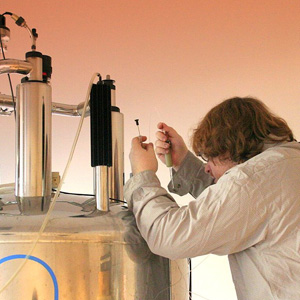Accueil > 1D NMR
Fast characterization of protein samples using liquid-state NMR
This platform can be used to characterize :The degree of folding of a protein The quantitative detection of the structural compactness of the protein. The oligomerisation state of the protein The interaction of the protein (or acid nucleic) with its partner in solution. Key wordsProtein Folding, interaction, 1D NMR, 2D NMR, SOFAST NMR, HET-SOFAST NMR ContactAdrien FAVIER Dedicated staff
Specific equipment600 MHz spectrometer equipped with HCN cryogenic probe Quality control of the spectrometer’s specifications is done quaterly and a standard sample is used in case of dysfunction. Websitehttp://www.ibs.fr/content/ibs/presentation/platform/quality Access modePSB users CostFree of charge for the PSB users LocationIBS LRMN How to make a request ?Use this online request form Additional informationDelay 1 week. Sample requirement : The minimum concentration should be about 100 µM. The sample volume is 600 μl. The NMR tube is furnished by the NMR lab. The most suitable buffers for NMR are phosphate and deuterated ones but the following buffers can also be used :
The salt concentration should be kept below 400 mM if possible. Traces of iron or paramagnetic buffer should be absent. AknowledgmentsPlease, add the following aknowledgments on your posters and publications : "This work used the platforms of the Grenoble Instruct-ERIC center (ISBG ; UAR 3518 CNRS-CEA-UGA-EMBL) within the Grenoble Partnership for Structural Biology (PSB), supported by FRISBI (ANR-10-INBS-0005-02) and GRAL, financed within the University Grenoble Alpes graduate school (Ecoles Universitaires de Recherche) CBH-EUR-GS (ANR-17-EURE-0003)" |


